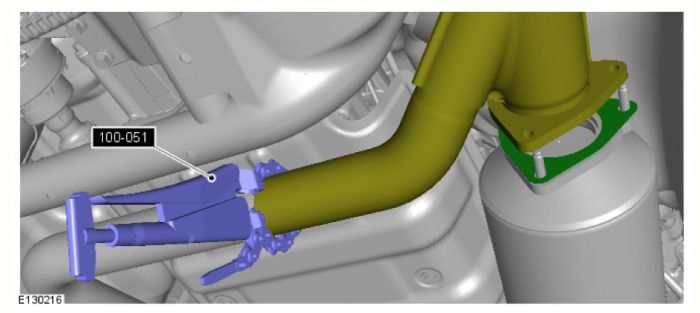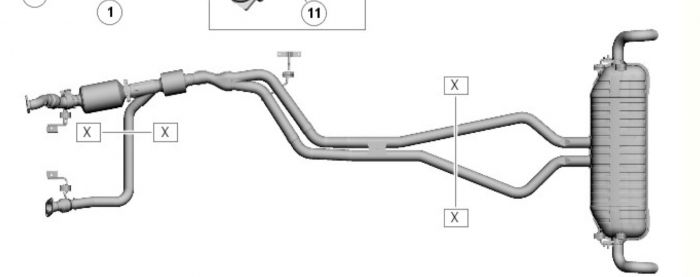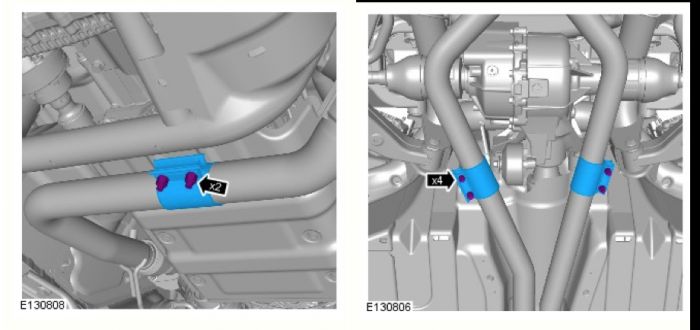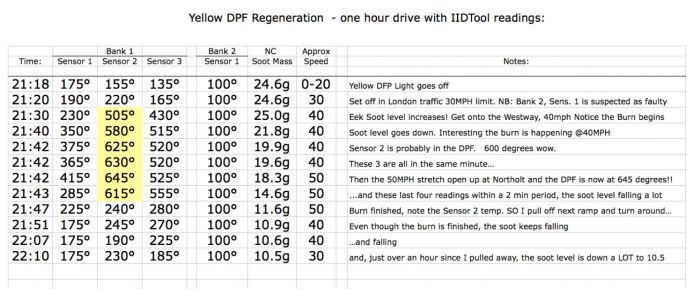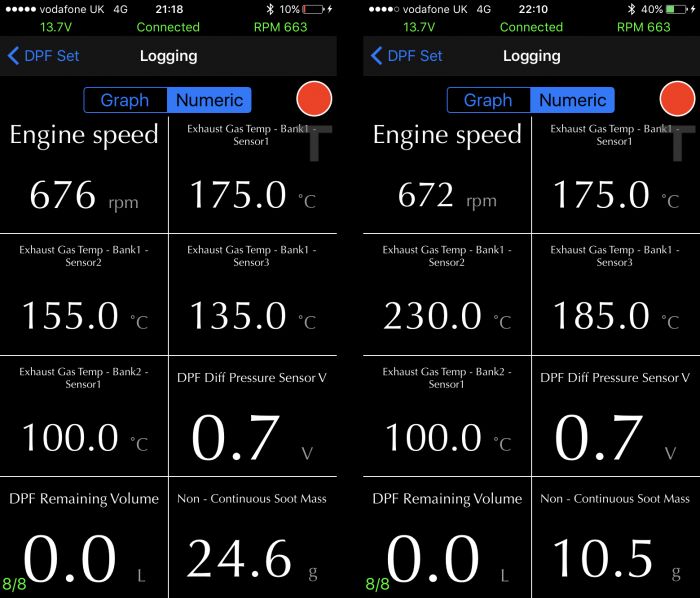 | Home > Maintenance & Mods (L322) > What to do if your DPF is blocked... |
 
|
|
|
| GGDR Member Since: 26 Nov 2016 Location: London Posts: 3551  
|
I've had my 2011 4.4TDV8 for 18 months. Bought it with over 100k miles on the clock. Not long after buying it the DPF yellow light went off. With rare motorway driving and a short commute, turns out I’m a terrible candidate for a diesel/DPF car. Who knew.
YELLOW LIGHT: 
You don't have to rag it, You don't have to hold the gears down and You don't have to keep the revs up. In the beginning that's what I did but I've now learned you can clear the DPF at 1200rpm. It's all about as little as 37mph min speed for a period of time. That's it. If you have an IIDTool you can see the EGT (Exhaust Gas Temps) rise, one in or just after the DPF goes up to 650degrees celsius. That's rocket hot. And it vaporises the soot. Having done several 'burns' (regenerations), according the the manual you need 50mph but on a yellow it knows it needs to do it urgently so it seems to lower this speed requirement. More on this below under 'passive regen'. I've cleared mine in 12, 9, 7 and even 3 mins. All you need is the above speed which is the requirement for the ECU to trigger the Regeneration. The reason is, I'm told, is that they've decided the airflow under the car is needed to keep the high temperatures safe for the environment around the car. I've heard of grass fires caused by 'static' regens. *See my glossary below. The other requirement (which I fell foul of recently) is low fuel. The ECU parameters also require at least a quarter tank. They want you to drive for up to 20mins, and the burn uses extra fuel so get some fuel in the tank before attempting a Regeneration. What happens if you ‘re 10mins into your 40-50mph regen and you hit traffic? It will start again, it may need less time once you resume speed. Your first run for 10mins may have dropped a few grams of soot, it's not a loss. It’s all automatic. Computers and stuff. There's a chart below on soot levels. A word of warning: - if you get a Yellow light, get yourself on a bit of 50mph road. Same day if you can. Otherwise don’t use the car until you can. A yellow light very quickly turns RED. Yellow is a cheap fix, but Red means your wallet is getting involved: RED LIGHT: DPF Full take to dealer 
The dreaded Red DPF light. Don’t panic. You can drive the car, there’s no need for a low-loader. Get yourself home or to your chosen mechanic and drop the car off. Don’t drive it (too much). You can if you need, but just try not to. Can't I just drive it at 50mph and Regen it? Might be worth a try? No, don’t try a Regen by getting back out on a 50MPH stretch, the car is in restricted mode and will not regen. The ECU locks you out. Can you clear a RED yourself? I’ve tried hard over the last few weeks to do just that, and I’ve not been able to. The IIDTool won’t do it. An iCarsoft (not the 930) will in theory, but I tried twice and it said “unsuccessful” I’ve googled deep and wide for a solution. And I’ve spoken to a lot of people, including iCarsoft. I spoke to a guy there and said I want to buy one, will it clear a red warning? They would not say yes. They even said they don't recommend it for clearing DPF's. UPDATE 10 June: see page 4 - Member SpitfireS says he cleared code: P2463 - DPF Restriction / Soot Accumulation dropping a RED warning (and removing limp mode) to a YELLOW and this enabling him to drive and do a regeneration - using ODBLink with ScanXL software Will Fuel Tank DPF additives work? Not likely in my opinion, although I haven’t tried. Post up any experiences, but if you do - please take soot readings using an IIDTool before and after. Otherwise snake oil rules apply. (i.e. disregard!) On this topic and the next, Land Rover say: Member Baltic Blue tested Millers Diesel Power Eco Max and reported: I would put premium fuels in the same category. I accidentally filled with Premium Shell one day and my DPF filled up at it's normal rate. Will DIY sprays work? You can unscrew sensors in the DPF and spray various DIY solutions in. The problem is you still need a professional-grade computer to carry out a Forced Regen to clear the RED fault. There is also a potential danger given the soot blowing out of your exhaust. I read it’s quite hazardous and so for this reason I’ve discounted this as an option. As above, post up any success stories (with before and after soot readings) What about intake system cleaning like Terraclean? Member Matt M with DPF problems reported:
Surely there’s some magic black box? Well yes - there is a dedicated DPF Dongle by DA Associates which costs around £180. http://www.fullfatrr.com/gallery/albums/us...0DPFDR.pdf This chap on youtube: ...says it works on his RRS. Whilst on a RED I was tempted but a guy on discosportforums.co.uk said:
I spoke to the guys at DA Associates and they would not commit to whether it would work or not. Very um-my and ahh-y. They even said Land Rover told them not to sell them any more. Twitchy you could say. If you’ve tried one on your Range Rover, let us know. - - - - - - - - - - - - - - - - - - - - - - - - - - - - - - - - - - - - - - - - - - - - - - - - - - - - - - - - - - - - - - - UPDATE OCTOBER 2019: I bought one of these DA-DPF Dongles and it reset the soot level to zero. But it would not clear the RED/restricted. However, once the soot was reset, I used my IIDTool to simply clear all errors, removing the RED then I used the DA Dongle to force a regen, although I had to wait until the soot level got above 17g So big success I've now cleared a RED myself for the first time. More info on Pg16. - - - - - - - - - - - - - - - - - - - - - - - - - - - - - - - - - - - - - - - - - - - - - - - - - - - - - - - - - - - - - - - I’m a fan of DIY. Why pay someone to do something when you can spanner yourself? But I tried and couldn’t clear it. So I decided I needed some expert help. Wait, what about the IIDTool? Your IIDTool won't do it. I asked Pat and he said can't sorry:
Your options: Yellow: Drive it at 50mph as above. Don't put it off. Go now. Red Option 1: Indy Land Rover Specialist - An Indy quoted £75 for a Forced Regen and they gave a 90% chance this would work. Mine, at 31g of soot is as full as it gets so I doubted that would work. And failed regens are not good for your engine. See chart below. Pros: pretty tempting as zero intrusion, Land Rover specialists Cons: may not work. won't clean the DPF fully, will only reduce soot level. Slight risk of diluting the oil Red Option 2: DPF Specialist In-Situ Clean: I got prices ranging from £200 to £275 These are professional versions of sensor-entry sprays. They unscrew a sensor and spray in chemical stuff. Sometimes a two-part system and usually a forced regeneration at the end. pros: also not very intrusive, cons: not convinced you get as deep a clean as the next option: And price-wise, they seem the same as a Opt 3 so why would you bother when you can get a superior solution for the same money: (*All my own personal opinion) Red Option 3: DPF Specialist Removal, Clean, Refit and Reset ECU: I got four quotes ranging between : £250 and £516 cons: exhaust needs to be cut to get it out pros: will be like new as cleaning off the car uses a dedicated machine. Fleet servicers use this option. London busses all have big DPFs and they rotate-clean them off the vehicles. Red Option 4: Fit a new DPF. cons: Price. See below what I paid for Option 3. A new DPF will cost a LOT. If you go to a LR dealer with a full DPF they probably have guidelines to fit new ones. That's going to hurt. pros: will be new. But what if it clogs again? So be careful. And find the cause. Spoke to loads of people and after a lot of research I went for Option 3. Cut off clean and refit. If you find the right place, it’s the same cost as option 2 but far better. OPTION 3 ON MY 4.4TDV8: So today I went to www.tdsrecon.co.uk North London, Hendon area. I liked these guys because the will remove and DPF, clean it, refit it and reset the ECU - all on site. Many don’t do that. Luka there is a turbo/egr/DPF specialist and he's got a £40,000 DPF cleaning 'flash' machine. It's a modest place ( If you trust your local Indy, get them to remove the DPF and send it away to one of the many trade DPF cleaning shops. They’ll get it back the next day all clean and refit it, clear the codes and you should be away. Luka cut off my DPF out . The LR workshop manual shows the following proceedure: Cut out:
3 cuts, X marks the spot:
Clamps to refit:
But Luka's machine is big enough that he did not have to cut the front section so only two cuts needed. Much better. DPF exhaust section out: ...and on the floor: Inside front face of DPF after cleaning. It looked cleaner to the naked eye than this pic: (Didn't get a before pic, sorry) I do have flow rates before and after: Before: 162 m3/h After: 390 m3/h Loving those numbers. He then plugged in his computer and cleared the codes. He did not need to do a Forced Regen as the cleaning was very successful. See flow rates which he said was virtually a new DPF flow rate. Some of the time it will need a Forced Regen and a 50mph run to reset it all. FYI Mine was pretty smokey for 10mins driving home, but then it was fine. Luka was getting anxious texts. TDSRecon charged me £250 and they had the car from 9am and gave it back, all faults cleared at 2pm. Luka's a good guy and he's a specialist in Turbos, EGRs and DPFs. I'd definitely recommend them, it's not cheap but it's also not expensive. And you can pay way more for the same service if you're not careful. There's a contingent of 'specialists' out there. You can tell from the sales patter when you ring. The price also gives them away. Many try to upsell you with things like intake system cleans etc. Luka's machine tells you flow rate but using my IIDTool I can also show you soot levels before and after:
I'll post some updates of the next week. Pretty worried actually it'll fill up again straight away. My car has not had the Turbo Drain Mod done but I've got my fingers crossed because the DPF has survived 107k miles on regens before I called it. Causes of DPF Full on a 4.4TDV8: 1. Never driving over 40mph. City driving is bad for DPFs. 2. Turbo Drain Mod - the oil builds up and clogs the DPF if you have not had the mod done 3. Overall mileage of your car - over time ash builds up. DPFs can only burn off soot, leaving the ash 4. Throttle Body (butterfly valve sticking) - I've read one story of this POSSIBLE CONTRIBUTORS: 5. Sensor failure, including the very common P040D-00(2F) Exhaust Gas Recirculation Temperature Sensor A Circuit High Error code. 6. Dirty MAF Sensor Or like me, a cocktail of several of the above. There are probably other causes too, I'm not a mechanic. - - - - - - - - - - - - - - - - - - - - - - - - - - - - - - - - - - - - - - - - - - - - - - - - - - - - - - - - - - - - - - - UPDATE 2019: I have changed my sensor and cleared the P040D-00(2F error and this seems to have made no difference to my DPF fill rate[/b]. - - - - - - - - - - - - - - - - - - - - - - - - - - - - - - - - - - - - - - - - - - - - - - - - - - - - - - - - - - - - - - - Glossary and more info: Passive Regeneration: These are your best friend - it means background regen when driving, The ECU starts a 'burn' provided a few parameters are met; a) Soot level over 17g. b) Fuel over 1/4 tank and c) speed over 50mph. I did this recently when my DPF showed 22g and I wanted to do a burn before I got a yellow at 23g. Once I got to a 50mph stretch the EGT's (Exhaust Gas Temps) wound up and the 22g fell away. After a 20min run out of town and return, my 22g ended up at 11g. Another was on the motorway and soot rose over 17g. The EGT's rose, burned the soot and the soot fell to 2.2g. All I had to do was drive at 50mph or higher, nothing more. Unless you have an IIDTool there is no way you'll know it's happening. Active Regeneration: Active means driving at 50mph while the ECU commands a regen including under a YELLOW DPF warning. Seems as mentioned above, this can happen from 37mph speeds (Possibly an urgency parameter built in). Forced Static Regeneration: Static means not driving. An external device forces the car to carry out a regeneration with the car sat there. Plenty on YouTube you can see with smoke billowing out. Wouldn’t personally recommend. Forced Active Regeneration: An external device forces a regen while driving at 50mph with the device hooked up. Most indys can do this. Should cost £100 or less, see Red Option 1. Soot vs Ash: DPFs catch soot and ash. I am told Regenerations get rid of soot but not ash which builds up and even after numerous successful regeneration cycles, the back end of the dpf will have a build up of ash/fine sand like particles blocking it. This is another reason I went for a full remove and clean. Other methods don't clear the ash. How blocked is blocked? The DPF system uses lots of monitoring, like flow rate, pressure differences, exhaust temperature. But the soot level seems the easiest way to assess your DPF. And here's a simple chart from the LR workshop manual:
If you have an IIDTool you can monitor your soot level. It's under LIVE VALUES > ENGINE Mine was at max which is as high as the sensors go I think. This shows that Option 1 really would not have worked for me. So use your IIDTool to assess your best path. The big lesson: I COULD HAVE AVOIDED REMOVING MY EXHAUST IF I HAD HAVE MONITORED MY SOOT LEVEL. I do this now, you need an IIDTool and you could check it every two weeks if you do a lot of city driving. If you're on the motorway, or regularly drive over 50mph, you are unlikely to have a problem at all. You can also have a read through many good threads on this site, including: http://www.fullfatrr.com/forum/topic43597-90.html A word of warning: Lastly, a true story: A guy's got a 4 year old fast diesel Merc CLS. He takes it to a remapping place and gets the DPF core drilled and mapped out. Takes it back to the main dealer for annual service. They report him to the DVLA and change his map back. Tampering with a DPF is illegal and you will fail your next MOT. The new MOTs check soot levels and you can't fool the readings. Don't do it. Plus we want clean air in this fine land. DPFs are a pain. But smokey diesels are worse for our lungs. Please post up experiences with any of the above. I'm keen to hear from any professionals too. Cheers, Greg Cheers, Greg - - - - - - - - - - - - - - - - - - - - - - - - - - - - - - - - - - - - - - - - - - 2011 Vogue SE 4.4 with lots of toys in Stornaway Last edited by GGDR on 20th Dec 2019 3:05pm. Edited 39 times in total |
||||||||||||||||||||||
|
| ilard Member Since: 21 Oct 2012 Location: London Posts: 713 
|
Wow, just feel like I’ve graduated from DPF university. Thanks, prof! |
||
|
| Joe90 Member Since: 29 Apr 2010 Location: Hampshire Posts: 6418 
|
Excellent helpful, useful, informative |
||
|
| GGDR Member Since: 26 Nov 2016 Location: London Posts: 3551  
|
A bit of an update from me at the DPF department.
|
||||||
|
| Baltic Blue Member Since: 13 Aug 2015 Location: North Wales Posts: 3811  
|
Great table of results Greg, very informative.
|
||
|
| stan Site Moderator Member Since: 13 Jul 2010 Location: a moderate moderated moderator moderating moderately in moderation Posts: 35606 
|
i had , for the second time only , the dpf yellow come up on sunday morning...in the early evening i drove for 15 mins around town at 30-35mph and the dpf surprisingly cleared ..i can only think it was the very high outside temperature that with the combination of the exhaust heat cleared the dpf... ... - .- -.
|
||
|
| GGDR Member Since: 26 Nov 2016 Location: London Posts: 3551  
|
Was it constant 30-35mph Stan or stop/start?
|
||
|
| stan Site Moderator Member Since: 13 Jul 2010 Location: a moderate moderated moderator moderating moderately in moderation Posts: 35606 
|
one stop for about 3 mins was included in that drive Greg.... ... - .- -.
|
||
|
| appj62 Member Since: 07 Aug 2013 Location: Cheshire Posts: 424  
|
I'll stick to petrol |
||
|
| Baltic Blue Member Since: 13 Aug 2015 Location: North Wales Posts: 3811  
|
Stan,
|
||
|
| stan Site Moderator Member Since: 13 Jul 2010 Location: a moderate moderated moderator moderating moderately in moderation Posts: 35606 
|
no p040d Mike...
|
||
|
| GGDR Member Since: 26 Nov 2016 Location: London Posts: 3551  
|
Stan just getting into the granular - was your 3 min stop engine running or engine off?
|
||
|
| John w Member Since: 14 Jan 2018 Location: Cranleigh, Surrey Posts: 439  
|
wow, what a read. Sorry to say I glazed over part way through the workshop manual post |
||
|
| stan Site Moderator Member Since: 13 Jul 2010 Location: a moderate moderated moderator moderating moderately in moderation Posts: 35606 
|
greg, engine off...
|
||
|
 
|
|
| All times are GMT + 1 Hour |
< Previous Topic | Next Topic > |
Posting Rules
|
Site Copyright © 2006-2025 Futuranet Ltd & Martin Lewis
![]()

